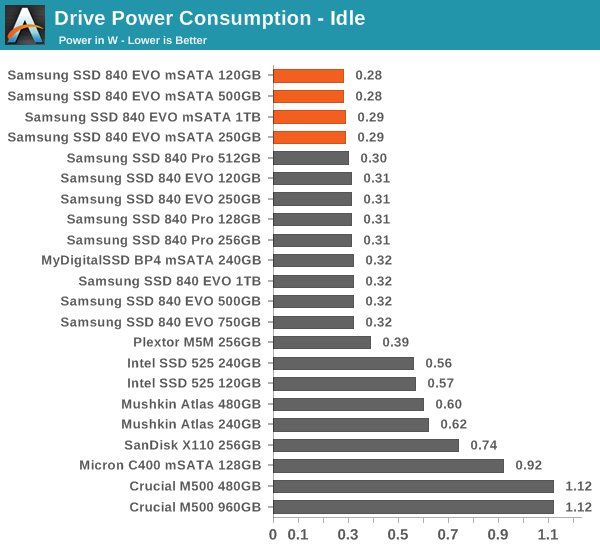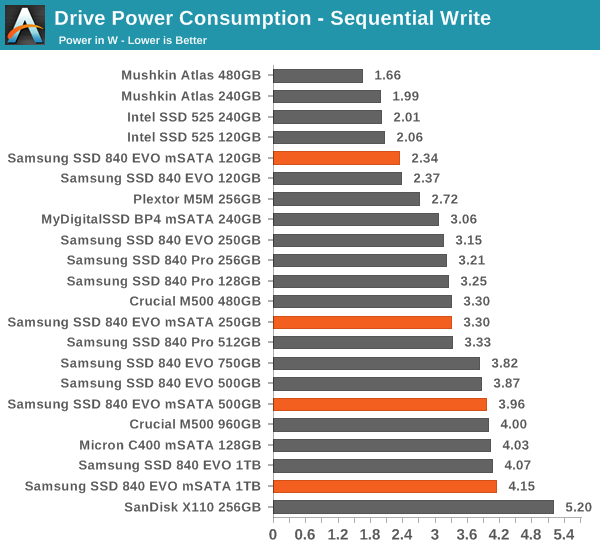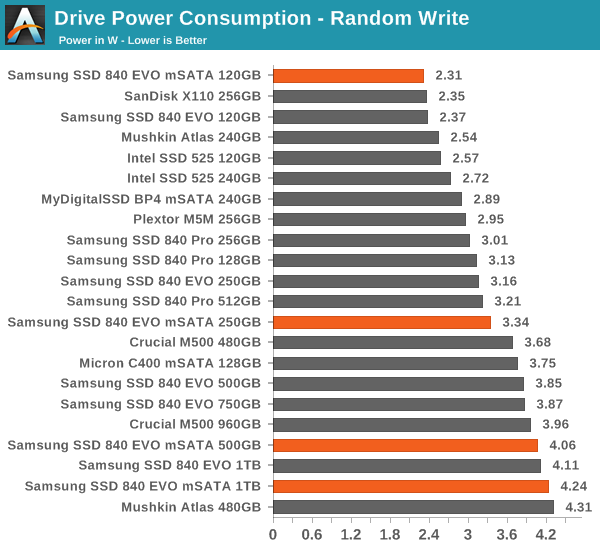Samsung SSD 840 EVO mSATA (120GB, 250GB, 500GB & 1TB) Review
by Kristian Vättö on January 9, 2014 1:35 PM ESTPower Consumption
One problem we have with testing mSATA SSDs is the fact that they require an mSATA to 2.5" adapter with a voltage regulator since 2.5" SATA is 5V whereas mSATA spec is rated at 3.3V. If you were to connect an mSATA SSD to a native mSATA slot, the power supply would automatically provide the drive with a voltage of 3.3V (SATA spec has three voltage rails: 3.3V, 5V and 12V) but because we have to deal with an adapter, the current we're measuring is based on the 5V rail (which the voltage regulator then changes to 3.3V). The voltage itself isn't the issue because it's fairly safe to assume that the adapter provides 3.3V to the drive but figuring out the difference between the input and output currents of the voltage regulator is. With the help of one of our readers (thanks Evan!), we were able to find out that the delta between input and output currents is typically 8mA (i.e. 0.008A) in the voltage regulator used in our adapter. Our measurements confirmed that as the adapter drew 8mA without a drive connected to it, although under load the regulator may draw a little more than that (datasheet claims a maximum of 20mA).
As we now know the difference between the input and output currents (current on 5V rail minus 8mA) as well as the voltage of the drive (3.3V), we're able to measure the actual power consumed by the drive. I've updated all mSATA SSD results to correspond with the change, so the number's you're seeing here are different from the ones you've seen in earlier reviews.
The EVO mSATA has great power characteristics, just like it's 2.5" sibling. There's no significant difference between the two and overall the EVO mSATA is one of the most power efficient mSATA drives. Unfortunately I don't have the necessary equipment to test slumber power consumption (HIPM+DIPM enabled) but I'd expect the EVO mSATA to have numbers similar to the 2.5" EVO (see the chart here).
The numbers here are worst-case scenarios and something I noticed during testing was that it takes a while for EVO to reach its maximum power draw. With the 500GB and 1TB models, the power draw was ranging between 2.2W and 2.5W for up to 30 seconds or so until it jumped to over 4W. I'm guessing this is due to TurboWrite because there is less NAND in use when the SLC buffer is employed (you simply don't need as many die to achieve high performance since program/erase times are much shorter). Once the buffer is full, the drive has to start writing to the TLC portion of the NAND, which increases the power draw as more NAND is in use. The downside is once you stop writing, the drive will keep drawing high power for a while in order to move the data from the SLC buffer to the TLC NAND. For example the 1TB model kept drawing ~3.5W for about a minute after I had stopped writing to the drive. I like Samsung's method because the garbage collection is done immediately instead of waiting for long idle periods like some manufacturers do -- doing garbage collection actively recovers performance quicker whereas it may take hours for idle garbage collection to kick in.













65 Comments
View All Comments
ahar - Thursday, January 9, 2014 - link
Can we also have one for the article? ;)"...so the number's you're seeing here..."
Unit Igor - Saturday, January 11, 2014 - link
Tell me Kristian please would EVO 120GB msata have any advantage over EVO 250gb msata in longer battery life when you compare power consuptipon vs. disk busy times and mb/s.I use my ultrabook only for mails ,somtimes wathing movies and surfing.I dont need more then 120GB SSD but i am willing to buy 250Gb if it would give me more battery life.What i wanted to see in your benchmark is MobileMark 2012 because msata is for laptops and that is where battery life play big roleguidryp - Thursday, January 9, 2014 - link
"endurance is fine for consumer usage"Thanks for your opinion, but I'll stick with MLC.
Do you also think Multi-TB HDDs are fine for consumer use? Since HDDs went over 1TB, they have been failing/wearing out for me regularly. I am sure you can find some theoretical numbers that say these are "fine for consumer usage" as well.
There is a big trend to bigger sizes but lower reliability. That trend can get stuffed.
Samsungs advantage of Being the only TLC player strikes me as a reason to avoid Samsung, so I can avoid TLC and decreasing endurance that goes with it.
Kristian Vättö - Thursday, January 9, 2014 - link
That's just your experience, it's not a proof that over 1TB hard drives are less reliable. We can't go out and start claiming that they are less reliable unless we have some concrete proof of that (failures on our end, statistics etc).The same applies for TLC. All we have is the P/E cycle number and frankly it gives us a pretty good estimation of the drive's lifespan and those numbers suggest that the endurance of TLC is completely fine for consumer usage. Or do you think our calculations are incorrect?
MrSpadge - Thursday, January 9, 2014 - link
And add to that that the P/E cycles are usually conservatively estimated by manufacturers. The SSD-burn-tests at XS sometimes exceed the ratings significantly.guidryp - Thursday, January 9, 2014 - link
I think if you examine any aggregate source of reviews like Newegg you will see a significant drop in drive satisfaction do to early failures, since drives went over 1TB. So it isn't just some personal fluke that half of my >1TB drives have failed worn out, so far.I am really sick of this trend of declining reliability being sold as good enough. If TLC is "good enough" I will take MLC with 3X "good enough" unless the we are talking about 1/3 the price for TLC.
Weren't the Samsung 840s failing in days for Anand last year?
Unlike reviewers, I use my products until they fail, so reliability matters a LOT, and is something that is going in the wrong direction IMO.
Kristian Vättö - Thursday, January 9, 2014 - link
Reliability is not the same as endurance. TLC has lower endurance, that's a fact, but it's not less reliable. Endurance is something you can predict (in the end all electronics have a finite lifespan) but reliability you cannot since there's a lot else than just NAND that can fail. I would claim that today's SSDs are much more reliable than the SSDs we had two years ago -- there haven't been any widespread issues with current drives (compared to e.g. early SandForce drives).Yes, we had a total of three 840 and 840 Pros that failed but that was on pre-production firmware. The retail units shipped with a fixed firmware.
This isn't a new trend. Historically we can go back all the way to 1920s when light bulb companies started rigging their products so the lifespan would be shorter, which would in turn increase sales. Is it fair? Of course not. Do all companies do it? Yes.
I do see your point but I think you're exaggerating. Even TLC SSDs will easily outlive the computer as a whole since the system will become obsolete in in a matter of years anyway if it's not updated.
gandergray - Saturday, January 25, 2014 - link
For information concerning hard drive failure rates that is more objective, please see the following article: http://www.extremetech.com/extreme/175089-who-make... .althaz - Thursday, January 9, 2014 - link
TLC is NOT a trade off in reliability, but a tradeoff in longevity.Longevity is measured in write-cycles and with heavy consumer loads TLC drives will still last for many years.
bsd228 - Thursday, January 9, 2014 - link
Other than the fact that they both store data, SSDs and HDDs have nothing in common, so it's silly to presume a problem that isn't really what you think it is in the first place. HDDs got dirt cheap as we cross the TB threshold and with it went diligent QA. You want 2TB for $80, you're going to get a higher defect rate. And going to 4 or 5 platters just increases the failure points, but the razor thin margins are the culprit here.In contrast, a bigger SSD just means either more chips, or higher density ones. But 16 chips is nothing new, and since there are no mechanical parts, nothing to worry about. Aside from OCZ, the SSD track record for reliability has been pretty solid, and Samsung (and Intel) far better than that. If you want to stick to 256G in your laptop out of a silly fear of TLC, you're just hurting yourself. The Anand guys have already shown how overstated the wear issue has become.